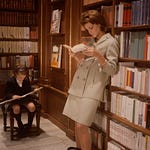One of my most unpopular opinions, going back more than 40 years now, is that I think Batman should be a light hearted character who cheerfully POWs and BANGs his way through a Gotham city filled with colourful villains. In other words, I'm a fan of the 1960s Batman TV show that starred Adam West. The more recent turn towards a dark and gritty Batman, which started in the early 1970s with the comic book stories by Neal Adams and written by Dennis O'Neil, has always struck me as wrong—even though individual movies and comic books in this mode occasionally give me some pleasure. O’Neil and Adams’ noirish spin on the character was taken to a new level of somberness by Frank Miller in a series of famous graphic novels, notably The Dark Knight Returns (1986, done in collaboration with Lynn Varley and Klaus Janson) and Batman: Year One (1987, done in collaboration with David Mazzucchelli).
It was with those prejudices in mind that I went to see The Batman, a film directed by Matt Reeves and starring Robert Pattinson as the caped crusader. This movie took the grim and gritty aesthetic to a new pitch of darkness. In fact, much of the film was barely visible. You had to strain your eyes to even figure out what is going on the screen.

The film seemed like a good occasion to talk about the evolution of Batman. I sat down with my frequent podcast guest Doug Bell to talk about both the movie and Batman as a character. We took up the 1930s emergence of Batman out of the pulp conventions of the mystery man genre, the domestication of Batman as a result of criticism in the 1940s and 50s, the camp Batman of the 1960s, and the more serious (or perhaps more ponderous) Batman that emerged out of the influence of Frank Miller. We also discussed the various iterations of Batman in movies and what distinguishes the most recent film from its predecessors.
(Post edited Emily M. Keeler)
Share and Subscribe
If you liked this post, please share:
Or subscribe:















Share this post